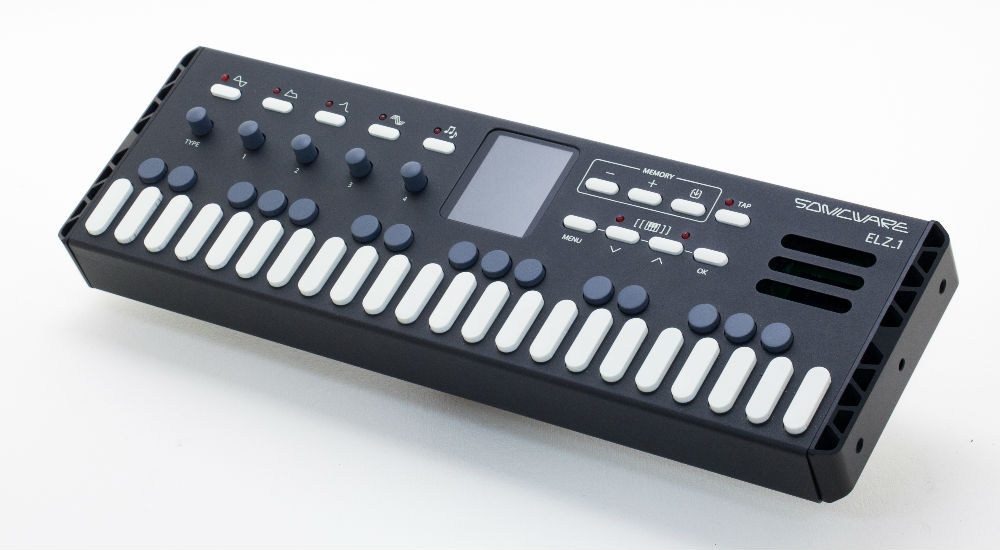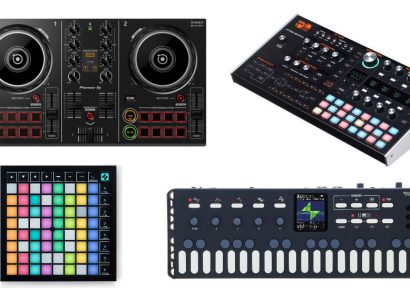If there’s been a single synth that’s shaken the world this decade, however, it’s been Teenage Engineering’s OP-1: a revolutionary creation from the Swedish firm that single-handedly sparked the mini-synth trend and wormed its way into the workflow of everyone from Thom Yorke to Metro Boomin. Due to an array of production issues in recent years, it’s now surprisingly difficult to land your hands on an OP-1 these days – which makes now the perfect time for Sonicware to step up to the plate with their ELZ-1 Portable Synth.
You’ve probably never heard of Sonicware, and that’s perfectly okay, because the ELZ-1 is actually the first product from the Japanese company. Billed by the manufacturers as a “reinvention” of the synthesiser, the ELZ-1 packs a whole lot into one sleek little chassis, combining FM synthesis, virtual analogue synthesis, 8-bit wavetable synthesis, noise synthesis, granular synthesis, a 64-step sequencer and squillions of filters and effects. It’s also got a built-in speaker, weighs just over a kilogram, offers USB/MIDI functionality and can be powered by four AA batteries, making the ELZ-1 the ultimate portable sound machine for any self-righteous tech-head.
Out of the box, it’s plain to tell that Sonicware mean serious business with their debut offering. Despite its breezy weight, the ELZ-1 is constructed almost entirely from solid metal, and even the little rotary encoders and 37 mini keys feel far from flimsy. The OLED screen is certainly worth a mention here; it really makes menu-diving and parameter tweaking a joy. By combining cartoony graphics with pragmatic depictions of waveform manipulations and ADSRs, the ELZ-1 provides an incredibly intuitive knob-twiddling experience to users of any level of pedigree. For beginners and hobbyists, playing with the ELZ-1 will certainly school you on the fundamentals of synthesis, and if you put your head down and get stuck into all the different elements it offers, you’ll know your way around envelopes, filters and LFOs in no time. Although the text displayed on the screen can be rather small at times, it’s never illegible, even when viewed from an angle or inside a dark, gloomy home studio – the primary habitat for most synth aficionados.
With so many different synth engines packed into the one tiny little box, it’s a little tough figuring out where to even begin with the ELZ-1, and even for pros, I’d recommend perusing the instruction manual. If you’re chasing “typical” synth sounds, you’ll want to dive into the Standard, Custom and Low Bit Oscillator engines and start fiddling with the sine, triangle, saw and square waveforms. These engines work great for when you’re seeking a solution for classic chords, soaring pads and bubbling funk leads, and serve as the best entry into navigating the interface of the ELZ-1. While lacking the traditional warmth of a true analogue sounds they’re emulating, these engines still do a pretty tight job, and I really dug the grit that the Low Bit Oscillator engine offered, particularly when you opened the filter up; a saw wave with a little slice of glide will take you straight to snarl central station, which is great for some stank-face inducing fun.
The ELZ-1 also boasts four operator FM synthesis, which I’m sure will tantalize a lot of users due to its potential for replicating those glassy, crystalline ‘80s sounds. I’m not a huge fan of FM synthesis, yet I found the FM engine of the ELZ-1 to be quite enjoyable and rather immersive; due in part to the level of engagement provided by the colourful OLED screen. Bell tones, chimes, electric pianos and flutes are all easily achievable and sound faithful, and you can provoke some extremely pretty, ambient tones when you engage them alongside the unit’s powerful arpeggiator. You can shape these sounds even further with the 8-bit Wave Memory Synth, which allows for waveform warping and morphing in the FM mode. The SiGRINDER granular synth engine and the two noise synths here also provides similar results, and if you’re seeking chirpy birdsound and crunchy 8-bit video game effects to complement a track, this one’s a go-go. If you’re feeling particularly adventurous, the ELZ-1 also contains a DNA explorer mode that lets you generate waveforms from incoming audio. It’s a metric tonne of fun, and deep-diving into this mode gives you some absolutely wild results: just be ready to waste hours of your time as it sucks you in further and further with each little discovery.
On top of all these synth engines, the ELZ-1 also boasts a whole heap of effects you can apply to your sound, allowing you to apply a huge range of modulation, drive and time-based effects to your current patch. This is a super thoughtful touch from Sonicware, particularly when you’re first learning the ins-and-outs of the synth and want to apply some overdrive, echo or LFO-like wobble without altering your workflow. It’s also worth noting that the Sequencer function on the ELZ-1 is phenomenal, and with 64 steps available to play with, you’ll find yourself stacking layers like crazy, creating wonderful polyphonic bleep-bloop patterns that you’ll never want to pry yourself away from.
As niche and toy as it may appear on a surface level, the Sonicware ELZ-1 is a super-serious piece of kit for the studio or the stage. While it excels in the weird and whacky, it also works wonders for classic mono and poly synth sounds, and once you’ve dedicated a few hours into wrapping your head around its fundamentals, it’ll start rewarding you like no other synth before it has. After years of market dominance, Teenage Engineering may have finally found itself a worthy rival in Sonicware.

